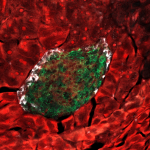RNA biology and biomolecular condensates
We previously showed that microRNA malfunction is mechanistically related to ALS and discovered that RNA-binding proteins, which are mutated in ALS, disrupt the microRNA biogenesis machinery. These studies reveal the involvement of small RNAs and particularly motor-neuron specific miR-218, in ALS neuro-pathology.
Biomolecular condensates, AKA, membraneless organelles, which are composed of RNA and RNA binding proteins, are an important interface for RNA biology / neurodegeneration research.
We use live cell imaging, APEX proximity proteomics, transcriptomics and machine learning approaches to characterize biomolecular condensates. We are interested in understanding the potential connection between stress granules and other membraneless organelles and the mechanisms for nucleation of insoluble aggregates that are present in patient brain and spinal cords.





